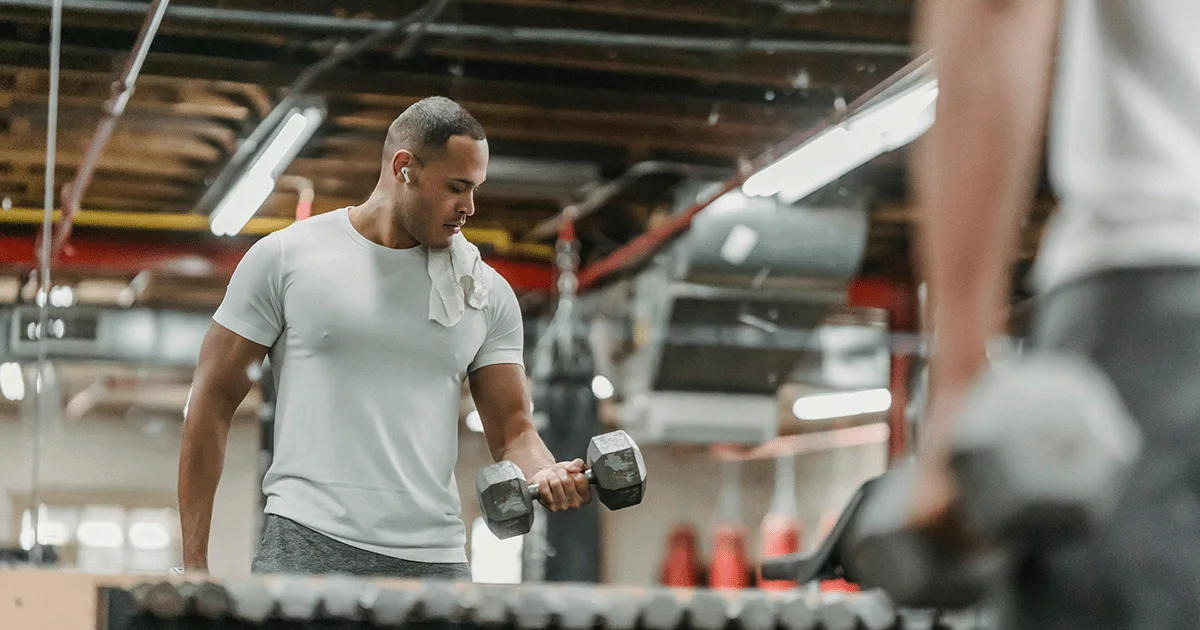Here's what we'll cover
Here's what we'll cover
Here's what we'll cover
Nothing feels better than a good workout. And once you get into an exercise routine, those endorphins will keep you coming back for more.
Exercise is about more than knocking out a bunch of push-ups and ramping up your heart rate. A regular exercise program also improves mental health, boosts energy levels, and helps you reach your fitness goals.
If you’ve never worked out before or are just getting back into the swing of things, here are some practical tips to help you start working out––and stick with it.
1. Build an exercise routine
Aim to make exercise a habit, just like brushing your teeth. That way it’s easier to stick with it.
Psychologists have studied for decades how simply repeating a task based on a particular cue (like always brushing your teeth before bed) eventually becomes a habit. The more you repeat the task, the more automatic it becomes, even when you’re not feeling motivated (Gardner, 2012).
To apply this idea to exercise, you just need to decide on a cue. For example, you can use time, picking a specific time to workout like after work. That way, once you’re done with your workday, you don’t have to hem and haw over if you feel like exercising––the decision has already been made for you.
Start by engaging in physical activity three days per week, with a rest day in between to allow your body time to recover.
2. Add it to your calendar
If a busy schedule has interfered with getting active before, start small. Making a little room for it in your calendar each week helps prioritize it and make physical activity a regular habit.
Plus, the more you exercise, the more you’ll enjoy benefits like less fatigue, less stress, and more energy (Childs, 2014; Puetz, 2006). All of a sudden, you may feel motivated to create more time in your schedule for exercise.
3. Find a workout that works for you
Lots of people have trouble exercising because they hate running or weightlifting. But there’s a lot more than that out there. Whether it’s power yoga or cardio hip hop, there’s bound to be an exercise out there you find enjoyable.
Working out shouldn’t feel like a chore. Make the process explorative and fun. Think of it like dating different types of exercise. Which one will win your heart?
4. Know what motivates you
Do you like to compete, or are you motivated by others? Try a team activity or group fitness class. Working out with a friend, walking with a neighbor, or even carpooling to Pilates class can help you stay accountable.
If tracking your progress motivates you, there are fitness apps to remind you of your goals. You can also try pairing exercise with a reward. Download your favorite TV show, audiobook, or podcast, but only allow yourself to listen or watch during or after your workout.
5. Incorporate exercise throughout the day
Gradually shifting away from a sedentary lifestyle makes exercise feel like less of a chore. If you do a little something every day, it makes it even easier. Exercise also doesn’t have to mean hitting the gym or blasting out a HIIT class. Try dancing while you do household tasks. If you work from home, try jumping rope or holding a plank between Zoom calls.
6. Listen to music
Speaking of dancing, music is known to boost both mood and mindset. Plus, it sets a tempo for your workout. Studies show that when people work out while listening to music, they tend to exercise longer and build more endurance––even though they don’t feel like they’re putting in more effort (Thakare, 2017; Thakur, 2013).
Faster music is more effective than slow music, especially if you’re a runner. Fast music is also good for maintaining or increasing your pace. Research indicates these effects are stronger for women (Van Dyck, 2015).
7. Set realistic goals
Goals can help you stay motivated––as long as they’re realistic. Some people set long-term goals for their workouts, but it’s also helpful to set smaller ones to keep you motivated along the way.
These might include upping your workout schedule from three days a week to four or increasing the amount of time you spend running by two minutes each week. You can also keep track of your progress by recording if you’re lifting heavier weights or doing more reps.
8. Get dressed for the occasion
Commit yourself to working out by getting dressed up for it. The night before, lay out your workout clothes. Putting your workout clothes on in the morning can help you visually commit to exercising later on in the day.
9. Workout in the morning
Some people find it easier to work out if they get it done first thing in the day. Then there are fewer excuses to shrug it off. However, research shows that both morning and evening exercise have their benefits, depending on the type of exercise. For example, studies have shown that (Seo, 2013):
People who practice resistance training in the morning enjoy more benefits than those who do so at night.
People who engage in high-intensity training in the evening have a greater work capacity (ability to recover quickly and repeat exercises without feeling tired) compared to sessions done in the morning.
Cyclists who exercise in the evening have been found to reach higher peak muscle power than morning cyclists.
10. Have a backup plan
If your go-to exercise is hiking with your dog and your town is hit with a weeklong spell of rain, figure out a backup you can do instead. This might be a kickboxing tutorial on YouTube, a jog on a treadmill at the gym, or a yoga class at a nearby studio.
Working out as a beginner
Are you working out for the first time? Try these individual tips for success.
Set achievable goals. Remember, you’re building a new habit. Improve your fitness levels with minor changes, like drinking one more cup of water daily or taking a short walk outside for 10 minutes.
Start small. Any exercise is better than no exercise. Going in full-hog and exhausting yourself with a 90-minute workout can be demotivating. You’ll stop before you get started. Starting slow and keeping with it can build confidence and motivation to keep going. Research also shows that multiple, shorter bouts of exercise can be just as effective in increasing aerobic fitness and weight loss compared to one longer session (Schmidt, 2001).
Identify your motivation for working out. Do you want to feel stronger? Build endurance? Lose weight? Boost self-confidence? Whatever your reason, remember to check back in with yourself any time you feel like skipping a workout.
Play it safe. Don’t overextend yourself. Always include a warmup and cool down with stretching. Pull back if you feel pain. If you have a medical condition, talk to a health professional first. If you want to customize your routine, consider hiring a certified personal trainer who can develop a workout plan tailored to you.
How to start working out at the gym
The gym can be scary, but it doesn’t have to be. Remember: everyone else is focusing on themselves, not you. So, stay present. Try to avoid making comparisons between yourself and others. Instead, focus on how the workout feels. Do you feel strong? Is your heart pumping? You’re working out. That’s awesome!
Exercising with others can make the gym feel more comfortable. Bring along a friend who supports you or connects with others if you’re unsure how to work the equipment.
Working out at home
Thanks to the pandemic, at-home workout options are better than ever. If you do better with the energy of a group environment, there are tons of live virtual classes to sign up for. If you prefer to go your own way, you can design your own workout routine with exercises you enjoy or follow along with an online tutorial.
How to start working out again
Whether you’re taking a break due to an injury, a new baby, or just life in general, it can feel daunting to get back into a fitness routine. Start small, be patient, and give yourself credit along the way––even if it feels like you’re not making progress.
It will take time to get back to where you were before you took your break, and that’s okay. It’s more important to establish a routine and build up from there. No matter where you are in your fitness journey, you have the power to incorporate more physical activity into your life. All you need to do is take the first step.
DISCLAIMER
If you have any medical questions or concerns, please talk to your healthcare provider. The articles on Health Guide are underpinned by peer-reviewed research and information drawn from medical societies and governmental agencies. However, they are not a substitute for professional medical advice, diagnosis, or treatment.
References
Childs, E., & de Wit, H. (2014). Regular exercise is associated with emotional resilience to acute stress in healthy adults. Frontiers in Physiology , 5, 161. doi: 10.3389/fphys.2014.00161. Retrieved from https://pubmed.ncbi.nlm.nih.gov/24822048/
Gardner, B., Lally, P., & Wardle, J. (2012). Making health habitual: the psychology of 'habit-formation' and general practice. The British Journal of General Practice, 62 (605), 664–666. doi: 10.3399/bjgp12X659466. Retrieved from https://pubmed.ncbi.nlm.nih.gov/23211256/
Puetz, T. W. (2006). Physical activity and feelings of energy and fatigue: epidemiological evidence. Sports Medicine (Auckland, N.Z.) , 36 (9), 767–780. doi: 10.2165/00007256-200636090-00004. Retrieved from https://pubmed.ncbi.nlm.nih.gov/16937952/
Schmidt, W. D., Biwer, C. J., & Kalscheuer, L. K. (2001). Effects of long versus short bout exercise on fitness and weight loss in overweight females. Journal of the American College of Nutrition , 20 (5), 494–501. doi: 10.1080/07315724.2001.10719058. Retrieved from https://pubmed.ncbi.nlm.nih.gov/11601564/
Seo, D. Y., Lee, S., Kim, N., Ko, K. S., Rhee, B. D., Park, B. J., et al. (2013). Morning and evening exercise. Integrative Medicine Research , 2 (4), 139–144. doi: 10.1016/j.imr.2013.10.003. https://pubmed.ncbi.nlm.nih.gov/28664065/
Thakare, A. E., Mehrotra, R., & Singh, A. (2017). Effect of music tempo on exercise performance and heart rate among young adults. International Journal of Physiology, Pathophysiology and Pharmacology , 9 (2), 35–39. Retrieved from https://pubmed.ncbi.nlm.nih.gov/28533890/
Thakur, A. M., & Yardi, S. S. (2013). Effect of different types of music on exercise performance in normal individuals. Indian Journal of Physiology and Pharmacology , 57 (4), 448–451. Retrieved from https://pubmed.ncbi.nlm.nih.gov/24968586/
Van Dyck, E., Moens, B., Buhmann, J., Demey, M., Coorevits, E., Dalla Bella, S., et al. (2015). Spontaneous entrainment of running cadence to music tempo. Sports Medicine - Open , 1 (1), 15. doi: 10.1186/s40798-015-0025-9. Retrieved from https://pubmed.ncbi.nlm.nih.gov/26258007/












